Multimedia from the 2004 Mariana Arc expedition
Videos | Virtual Fly-Throughs |Virtual Realities2004
Videos: Ocean Explorer Return to the Mariana Arc |
||
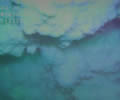 |
ROPOS at the edge of Brimstone Pit near the summit of NW Rota 1 volcano, showing ash and sulfur laden eruptions from the crater. The crater is at a depth of 555 meters. The yellow color of the billowing clouds is due to droplets of molten sulfur in the plume bursts. (Quicktime:OE site- 2 MB | full-size 21.1 MB) | |
 |
ROPOS at the edge of Brimstone Pit near the summit of NW Rota 1 volcano, showing a burst of ash, sulfur, and small rocks from the crater. This type of activity has probably never been witnessed on a submarine volcano before. (Quicktime: OE site- 2.1 MB | full-size 22.5 MB) | |
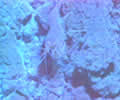 |
We found two species of shrimp at the hydrothermal vents at NW Rota 1 volcano - one large and one small. The small one may be a new species. They both graze on the microbial mats found around the vents. (Quicktime:OE site- 1.9 MB | full-size 19.3 MB) | |
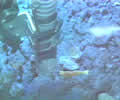 |
Biological specimens are collected to identify and study the unusual species found at hydrothermal vents. The shrimp at NW Rota 1 volcano were difficult to capture and required patience from the scientists and dexterity by the ROPOS pilots controlling the suction sampler. The control room celebrates after a long and anxious pursuit. (Quicktime:OE site- 1.5MB | full-size 15.4 MB) | |
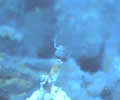 |
Hot water at 240 degrees Celsius (460 degrees Fahrenheit) vents from chimneys made of sulfide minerals at the Black Forest site at East Diamante volcano. This temperature is right at the boiling point at this depth (345 meters) and bubbles of gas or steam can be seen escaping from some of the chimneys. (Quicktime:OE site- 1.9 MB | full-size 19.9 MB) | |
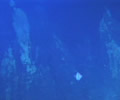 |
The Black Forest chimney field at East Diamante volcano is a linear zone on the side of a cone inside the caldera of the volcano. This is about as shallow as black smoker vents can form (345 meters), vividly illustrated when an angel fish swims by. It is safe to say that black smoker chimneys and reef fish are almost never seen together in the same view! (Quicktime:OE site 620 KB | full-size 6.5 MB) | |
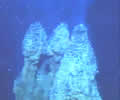 |
This sulfide chimney at East Diamante volcano is 9 meters tall and is actively venting hot water that appears smokey because of entrained mineral particles. The chimney was later renamed to "Five Towers" after more active vents were found on the other side. (Quicktime: OE site- 1.7 MB | full-size 20.2 MB) | |
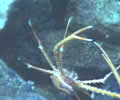 |
The dives near hydrothermal vents at East Diamante volcano (between 300-350 meters depth) encountered animals such as crabs, basket stars, crabs, barnacles, and snails. (Quicktime: OE site- 1.9 MB | full-size 16.0 MB) | |
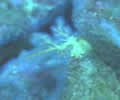 |
A ROPOS transect made from 200 up to 165 meters depth on the central cone at East Diamante volcano found a remarkable zone where chemosynthesis and photosynthesis overlap. Here, life forms dependent on chemical energy usually found in the deep ocean, are seen in the same area as animals dependent on sunlight. (Quicktime: OE site- 1.4MB | full-size 19.0 MB) | |
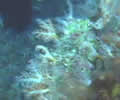 |
The "Aquarium" site at East Diamante volcano is a lush marine community located in the deepest part of the photosynthetic zone. You can tell by the excited voices of the scientists that the abundant and colorful life here contrasts dramatically with the sparser biological communities they are used to seeing at deep ocean hydrothermal vents. (Quicktime: OE site- 1.9 MB | full-size 17.5 MB) |
|
 |
Maug island consists of three islets that form the rim of a volcanic crater flooded by the sea. The R/V Thompson made two dives inside the crater at Maug with the ROPOS remotely operated vehicle. This movie shows a ROPOS deployment from several different points of view. (Quicktime: OE site- 1.9 MB| full-size 17.1 MB) | |
 |
Bubbles of liquid carbon dioxide rise from hydrothermal vents at NW Eifuku volcano. At this pressure (2300 pounds per square inch) and temperature (2C or 36F) carbon dioxide is a viscous sticky liquid, evident in the way that it accumulated on the undersides of the ROPOS vehicle. (Quicktime: OE site- 1.9 MB | full-size 25.5 MB) | |
 |
An extraordinary biological community exists at NW Eifuku volcano that is dominated by a very large and densely populated bed of hydrothermal mussels. Other vent animals at the hot springs include crabs, shrimp, scale worms, and limpets. (Quicktime: OE site- 1.8MB | full-size 19.4 MB) | |
 |
Around some of the seafloor hot springs at NW Eifuku volcano, strange-looking mounds of sulfur have been built that have thin finger-like projections. Each "finger" has a small crater at the top where molten sulfur has been expelled to build up the mound. (Quicktime: OE site 1.8MB | full-size 52.7 MB) | |
 |
This movie shows the discovery of Champagne vent at northwest Eifuku volcano, where bubbles of liquid carbon dioxide are actively venting from seafloor hot springs. This unusual behavior is due to the fact that the emissions from NW Eifuku volcano are particularly gas-rich. The high pressure at this depth keeps the carbon dioxide in a liquid state; Champagne vent is at a depth of 1607 m (5270 ft). (Quicktime: OE site 1.9MB | full-size 17.2 MB) | |
 |
Cliffhouse vent is located at northwest Eifuku volcano on the upper edge of a large field of hydrothermal mussels. Areas of shimmering water attract other vent animals such as shrimp and limpets. (Quicktime: OE site 1.8MB | full-size 23.8 MB) | |
 |
Large areas of the summit of northwest Eifuku volcano were covered with orange bacterial mat. This mat is the biproduct of hydrothermal microbes growing in areas where warm water is seeping out of the volcano. On steep slopes, the mat sometimes cascades downhill as "bacteria balls". (Quicktime: OE site 2 MB | full-size 24.6 MB) | |
| Virtual Fly-throughs: Ocean Explorer Mariana Arc (click image for site) | ||
 |
Fly-through of 2004 towyos and bathymetry at NW Rota-1 submarine volcano.
Quicktime (*.mov): 1MB | 4MB Windows Media Video (*.wmv): .4MB | 4MB |
|
 |
See the satellite and sonar survey animation of the Mariana Arc Volcanic Chain (Quicktime 3.4 MB) | |
 |
Take a trip to the seafloor of the Mariana Arc! (Quicktime 2.6 MB) | |
 |
Fly-over the NW Uracas and Ahyi submarine volcanoes (Quicktime 3.3 MB) | |
| Virtual Realities: Ocean Explorer Magic Mountain Virtual Site (click image for site) | ||
 |
Take a trip to the seafloor! Explore the hydrothermal vents of the Magic Mountain Chimney Fields via a series of interactive computer animations and videos. (Where is Magic Mountain?) | |
